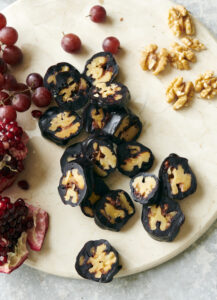
Churchkhela
Ingredients
- 5 pounds/2.2 kg red grapes or 1½ quarts/1.5 liters unsweetened pure grape juice
- 50 whole, large walnut halves
- ½ cup/68g all-purpose flour
- 2 tablespoons sugar (optional)
Instructions
- Remove the grapes from their stems and stalks and put them through a food mill. This can be an arduous task if the skins are thick. It helps to crush the grapes with a mallet before putting them through the mill; after the first round of pressing, put the pulp through the mill a couple more times to release as much juice as possible.
- Transfer the juice to a medium saucepan and simmer over very low heat, uncovered, for about 3 hours, until the juice is reduced by a little less than half. The consistency should be fairly thick. Taste the juice and add a little sugar, if desired.
- Let the juice stand overnight, covered, and then pass it through a fine sieve. You should have 3 cups/700 ml of thickened juice. Return the juice to the saucepan.
- In a 12-inch/30 cm skillet, heat the walnut halves over very low heat until they are slightly toasted; alternatively, bake them at 350ºF/175ºC for 6 to 8 minutes. Be careful not to let them brown. Set aside.
- While the nuts are cooling, prepare the setup. Lay a dowel or broom handle across two chair seats of equal height and place newspaper underneath the dowel to catch any drips. Thread a sturdy needle with a 3-foot/91 cm length of 1/16-inch/.1 cm thick twine. Pull the ends of the twine together at the bottom and tie them into a knot.
- Carefully thread a walnut half onto the twine, flat side up. The nuts are less likely to break if you find a spot slightly off center, rather than along the central ridge. It’s not a problem if a little bit of the nut breaks off, but if it shatters, select another walnut half. Push the first strung walnut to a point 1½ inches/4 cm above the knotted bottom.
- Repeat with half of the remaining walnuts until you have threaded 25 nuts onto the twine, each one flush against the next. Cut the needle from the twine at the top and knot the ends. Repeat with the second length of twine and the remaining 25 walnut halves. Set aside.
- Place the flour in a medium bowl. Heat the grape juice to just below boiling and gradually whisk it into the flour, whisking vigorously so that lumps don’t form. (If they do, simply put the juice through a fine-mesh sieve.) Return the juice to the saucepan and bring to a boil. Reduce the heat to low and cook for a few minutes, stirring, until the mixture thickens further and no longer tastes of flour.
- Reduce the heat to its lowest setting. Take one strand of nuts and dip it repeatedly in the grape juice, using a spoon to pour juice over the top of the nuts so that they are completely coated. Carry the strand over to the chairs and loop it over the dowel. The excess juice will drip onto the newspaper. Repeat the procedure with the second strand, then remove the pan from the heat.
- Allow the nuts to dry for 20 minutes. Then gently reheat the juice and dip each strand in it again to create a second layer of coating. If the juice gets too thick, add a little grape juice, apple juice, or water to bring it to a workable consistency. Let the strands dry on the dowel a second time for 20 minutes, then repeat the process 2 more times, so that the nuts have 4 layers of coating.
- Let the strands dry for about 4 days, or until they are no longer tacky to the touch, then remove them from the dowel. Churchkhela keeps for a long time but is best when consumed within three to four months.
Makes 2 strands
Recipe by Darra Goldstein at https://darragoldstein.com/churchkhela/